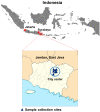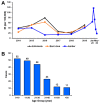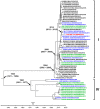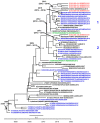Dengue Virus Serotype 4 Is Responsible for the Outbreak of Dengue in East Java City of Jember, Indonesia
- PMID: 32825262
- PMCID: PMC7551817
- DOI: 10.3390/v12090913
Dengue Virus Serotype 4 Is Responsible for the Outbreak of Dengue in East Java City of Jember, Indonesia
Abstract
Outbreaks of dengue virus (DENV) in Indonesia have been mainly caused by the DENV serotype-1; -2; or -3. The DENV-4 was the least-reported serotype in Indonesia during the last five decades. We recently conducted a molecular epidemiology study of dengue in the Jember regency, East Java province, Indonesia. Dengue is endemic in the region and outbreaks occur annually. We investigated the clinical characteristics and etiology of dengue-like febrile illness in this regency to understand the disease dynamics. A total of 191 patients with clinical symptoms similar to dengue were recruited during an 11-month study in 2019-2020. Children accounted for the majority of cases and dengue burden was estimated in 41.4% of the cases based on NS1 antigen, viral RNA, and IgG/IgM antibody detection with the majority (73.4%) being primary infections. Secondary infection was significantly associated with a higher risk of severe dengue manifestation. All four DENV serotypes were detected in Jember. Strikingly, we observed the predominance of DENV-4, followed by DENV-3, DENV-1, and DENV-2. Genotype determination using Envelope gene sequence revealed the classification into Genotype I, Cosmopolitan Genotype, Genotype I, and Genotype II for DENV-1, -2, -3, and -4, respectively. The predominance of DENV-4 in Jember may be associated with a new wave of DENV infections and spread in a non-immune population lacking a herd-immunity to this particular serotype.
Keywords: Indonesia; Java; dengue; molecular epidemiology; serotype.
Conflict of interest statement
The authors declare no conflict of interest.
Figures







References
-
- World Health Organization . Comprehensive Guidelines for Prevention and Control of Dengue and Dengue Haemorrhagic Fever. WHO Regional Office for South-East Asia; New Delhi, India: 2011. (Revised and Expanded).
Publication types
MeSH terms
LinkOut - more resources
Full Text Sources
Medical

